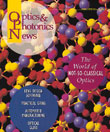
June 1994 Issue
Feature Articles
Computer [Aided] Optics Manufacturing
Flexibility and time-based performance are just two of the measures that differentiate manufacturers in the aggressive environment of global competition. In most industries, computer numerically controlled machining centers are considered a basic necessity in the battle to maximize flexibility, increase speed, and achieve the consistent perfection required by today's quality-conscious buyer. But, while computer-assisted machining has been readily available in most industries, it was not an option for optics manufacturers until recently. In 1993, the computer-controlled Opticam™ equipment developed at the Center for Optics Manufacturing (COM) became commercially available. Today, Opticam™ machining centers are eliminating the specialized tooling, long cycle times, and special craft skills required with conventional manufacturing equipment.
by Harvey Pollicove, Don Golini, and Jeff RuckmanLens Design Doing More With Less
Some might think that writing an article about lens design would result in the generation of an historical document. Not true; activity in the field is greater than ever, and the field is accessible to a wider audience than ever before. The traditional view of lens design as a subject carried out by a few unusual individuals has changed. Anyone with interest and a few bucks can get access to the latest and greatest software, on their own personal computer.
by Robert R. ShannonPractical Grins: Materials, Design, and Applications
Gradient index (GRIN) optical materials have remained a novelty for over 100 years. Only recently have applications beyond photocopy and facsimile imaging arrays and fiber couplers begun to emerge. These new applications are largely driven by advances in the manufacture of GRIN materials and the more widespread understanding of GRIN properties and anomalies by optical design engineers. This article reviews where GRIN has been, new GRIN materials, how to design with GRIN materials, where we think GRIN is going, and some current applications being pursued by Gradient Lens Corp. (GLC). For a more complete bibliography of gradient index technology, see Marchand or Moore.
by Leland G. Atkinson III, Douglas S. Kindred and J. Robert ZinterA television is a device many children see nearly every day. I thought it might be interesting to see how several kids think a TV works, and then put together some experiments to help them understand more about it. I started by interviewing a few kids between ages 3 and 16. Starting with Mitchell, age three, I asked if he thinks Big Bird is inside the TV, or if he's looking at pictures of Big Bird. He told me, "Big Bird is inside. He's inside the box." His mother told me he really seems to believe that, and he hides behind the couch when the giant arrives in "Jack and the Beanstalk"! Six-year-old Janelle, when asked the same question, informed me that she's too old for "Sesame Street."
by Janet ShieldsA Synopsis Of Standards Activity
As I was filing draft international optical standards and their updates in my notebooks, it became quite obvious to me how much activity there has been in this area in the last year or so. This suggests it might be a good time to recap recent events and indicate some of the individuals heading up the efforts in the U.S.
by Robert E. ParksProgress in optics has been coupled to progress in glass from the time of Galileo's first telescope. In recent years, glass has been repeatedly reincarnated as a still more important class of optical materials. Its use and our understanding of its nature are changing in ways that were unimaginable 20 years ago.
by S.N. Houde-Walter

![Manual probe system with needles for test of semiconductor on silicon wafer. [A. Morozov / Getty]](https://opnmedia.blob.core.windows.net/$web/opn/media/images/articles/2025/1125/departments/202511-cover-web.jpg?ext=.jpg)
![Researcher Clara Saraceno in the lab. [Image by Carsten Behler Photography]](https://opnmedia.blob.core.windows.net/$web/opn/media/images/articles/2025/1025/departments/202510-cover-web.jpg?ext=.jpg)
